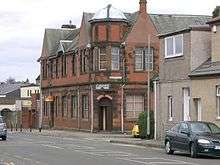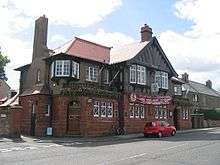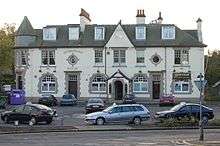Gothenburg Public House System

The Gothenburg or Trust Public House system originated in the 1860s in Gothenburg, Sweden[1] in an attempt to control the consumption of spirits. Earlier in the century, 34 litres annual per capita consumption of spirits was recorded in Sweden. In 1855 the country proscribed domestic distillation. The city of Gothenburg awarded its sole retail licence for spirits to a trust, with the aim of controlling consumption.[2][3] The shareholders of the trust were to receive a maximum return of 5% annually and all other profits were to be used to benefit the local community. The town treasury was to control the income generated and use it to provide libraries, museums, parks and other community facilities. The success of the system led to its spread throughout Sweden and further afield.[2][3]
In Scotland


In Scotland, pubs run under the Gothenburg system are often colloquially known as "Goths".[4][5]
Although controversial within the movement, some Scottish temperance campaigners advocated the system. The passing of the Industrial and Provident Societies Act 1893 allowed its adoption,[6] and it took hold, particularly in coal mining communities, where mining companies had previously opposed the granting of pub licences.[2][3][6] There were several 'Goths' in the Lothians, one each in Stirlingshire and Ayrshire and, prior to 1914, more than twenty in Fife, where the system took its strongest hold;[1][6] strong links between Fife and Sweden had been established in the late nineteenth and early twentieth century due to the supply of coal to Swedish Railways by the Fife Coal Company.[5] The local coal companies were often a source of funds to establish these pubs and were usually a dominant force on the boards of the trusts, with the miners themselves usually holding representation and sometimes contributing in part to the capital.[1][2][3]
A premise of these pubs was that they were not to be attractive or welcoming, to discourage drinking, and the sale of spirits was not to be encouraged.[2] No credit was given and betting and gambling were banned, as were any form of game or amusement (even dominoes).[1][6][7]
Examples of facilities and beneficiaries funded by the system included libraries, museums, parks, bowling and cricket grounds and pavilions, cinemas, community centres or 'Gothenburg halls' and grants to galas, charities, clubs and societies and for the funding of district nurses and ambulances.[1][2]
Today, some of these establishments remain as pubs but only the Dean Tavern in Newtongrange, the Goth in Armadale, the Prestoungrange Gothenburg in Prestonpans.[8] and the Gothenburg in Fallin, Stirling[9] are still run under the Gothenburg system.
In England
Joseph Chamberlain took an interest in the Gothenburg system and proposed a version of it to a Parliamentary Select Committee on Intemperance in 1877.[10] This did not gain momentum but the issue was raised again in the 1890s by the Bishop of Chester, Francis Jayne, who wrote letters to The Times and published articles on the subject.[11] He also founded the People's Refreshment House Association Limited.[12] His ideas were not approved of by the Church of England Temperance Society who were hostile to the idea of "working men" having improved pubs and encouraged them to make home and family the focus of their leisure time.[10] As well as Jayne's association which had 130 establishments, there was a similar "Gothenburg-inspired"[10] group called the Central Public House Trust Association which owned about 250 "trust houses" in England and Wales by 1914.[10]
Cultural references
The Number One Goth in Cardenden was referenced by Ian Rankin as the first pub in which his character John Rebus bought a round of drinks.[13] Parts of Irvine Welsh's novella Kingdom of Fife are set in the New Goth in Cowdenbeath.[14] The pub in the fictional village of Newton of Wemyss in A Darker Domain by Val McDermid was formerly a Goth.[15]
See also
References
- 1 2 3 4 5 Duncan, Robert (2005). The Mineworkers. Edinburgh: Birlinn. p. 192. ISBN 1-84158-365-0.
- 1 2 3 4 5 6 "The Gothenburg Public House System". Pathfinder Pack on The Gothenburg Public House System. Resources for Learning in Scotland. Retrieved 12 February 2011.
- 1 2 3 4 "Gothenburg Public Houses". Scottish Mining Website. Retrieved 12 February 2011.
- ↑ http://www.thegoth.co.uk/15.html
- 1 2 Jack, Ian (16 October 2016). "16/10/2016, Good Morning Scotland - BBC Radio Scotland". Good Morning Scotland (Interview). Interview with Gordon Brewer. BBC Radio Scotland. 55:50 minutes in. Retrieved 16 October 2016.
...the Fife Coal Company in particular exported lots of coal leading up to the 1914 war and I suppose the last twenty years before… to Swedish Railways, so there was a kind of traffic between Sweden and Scotland and there was a model society, as it were, in Gothenburg in which communities owned things, like pubs, together, jointly and the profits from the takings from alcohol went into improvements such as…tennis courts, new street lighting or whatever and that model was brought back to Fife especially… as you say it may well appear in Fallin and Prestonpans as well, I didn’t know that, and these pubs were run by these things called the Gothenburg Society and they were known as “Goths”. I think in Dunfermline there was the Top Goth and the Bottom Goth, I’m not sure now and… what was the joke at school… When Did You Last See Your Father was the picture… “doon at the Goth!”.
- 1 2 3 4 Hutton, Guthrie (1999). Fife – The Mining Kingdom. United Kingdom: Stenlake. p. 44. ISBN 978-1-84033-092-2.
- ↑ "Hill of Beath Tavern". Scottish Mining Website. Retrieved 13 February 2011.
- ↑ Cooper, Malcolm. Raising the Bar. Historic Scotland. p. 29. ISBN 978-1-84917-012-3.
- ↑ "The Gothenburg : News - Discovered: another Goth still prospers @ Fallin - by Stirling". Prestoungrange.org. 2010-09-10. Retrieved 2014-04-12.
- 1 2 3 4 James Nicholls, The politics of alcohol: A history of the drink question in England, OUP 2013 pp139-141
- ↑ Francis John Jayne, 'Successful Public-House Reform' in The North American Review 158, no. 450 (1894): 520-28
- ↑ "Joseph Chamberlain".
- ↑ Allardyce, Jason (10 March 2002). "Audit Scotland in second Fife Council probe". The Scotsman. Retrieved 13 February 2011.
- ↑ Welsh, Irvine (2007). If You Liked School, You'll Love Work... London: Jonathon Cape. pp. 205 onwards. ISBN 978-0-224-07588-6.
- ↑ McDermid, Val (2008). A Darker Domain. Harper Collins. p. 41. ISBN 978-0-00-724329-7.
External links
- Transcript of British 'Gothenburg' Experiments and Public-House Trusts by Joseph Rowntree and Arthur Sherwell (1903)
- A Short History of the Armadale Public House Society Limited
- Web site of The Dean Tavern
- Facebook page of Fallin Gothenburg
- Web site of Prestoungrange Gothenburg
- Related images at the Scran educational resource